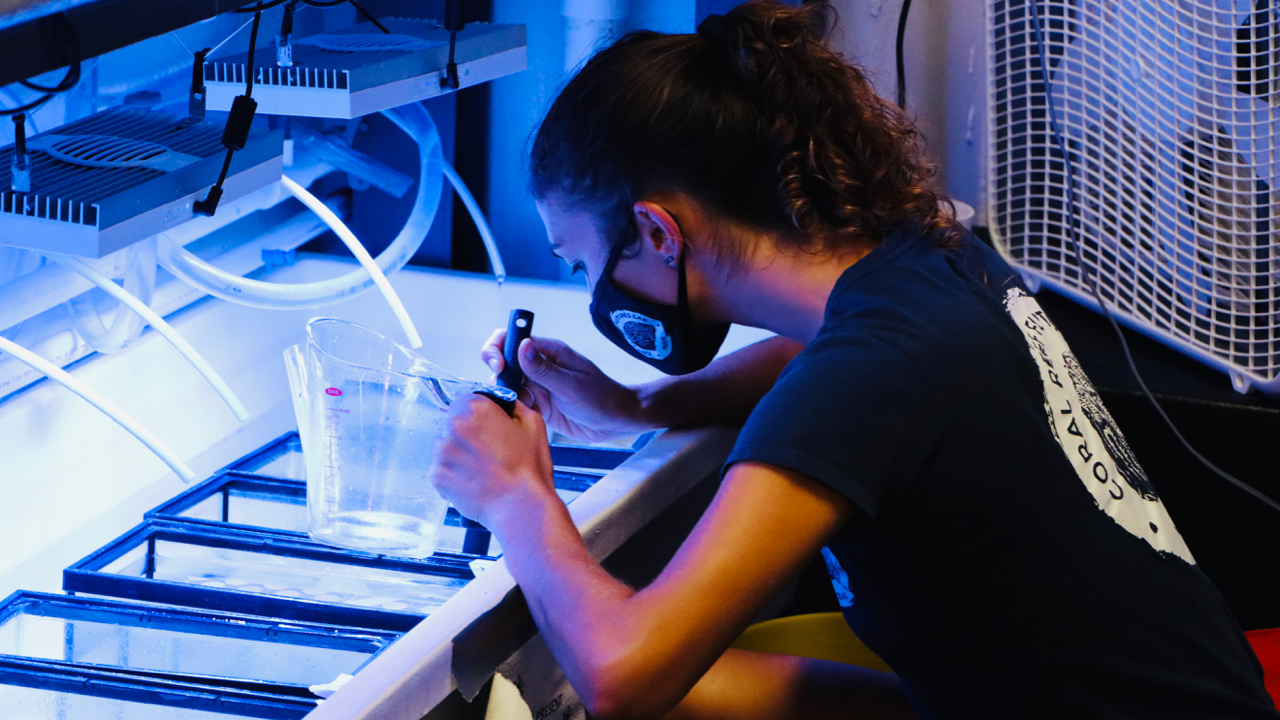MIAMI—For the first time, grooved brain corals rescued from a disease outbreak and maintained in human care have been bred with wild corals that survived the disease, in a collaborative restoration initiative between scientists at the University of Miami (UM) Rosenstiel School of Marine and Atmospheric Science and the Florida Aquarium Center for Conservation.
This breakthrough research effort represents the first-time cryogenically preserved sperm has been successfully used to crossbreed brain coral parents from different locations, with the goal of enhancing genetic diversity and disease resistance to help protect and restore Florida’s depleted coral reefs.
Reefs in Florida have been devastated by stony coral tissue loss disease, which has affected over 20 coral species to date. Since first appearing in 2014, it has spread throughout most of Florida’s Coral Reef as well as to other reefs in the Caribbean. In 2018, the Florida Coral Rescue Team, led by the Florida Fish and Wildlife Conservation Commission (FWC) and NOAA Fisheries, began removing corals from ahead of the disease boundary before they were affected by the outbreak, and distributed them to public aquaria around the U.S., to safeguard the genetic diversity and help restore reefs in the future.
Earlier this month, UM Rosenstiel School scientists fertilized eggs from wild Miami colonies of the grooved brain coral, Diploria labyrinthiformis, using frozen sperm collected from rescued corals, which the Florida Aquarium has maintained in human care since 2018.
At the same time, Florida Aquarium scientists fertilized eggs from rescued corals using frozen sperm from wild corals that spawned in Key Largo and which was collected by scientists from UM Rosenstiel School, UM’s Cooperative Institute for Marine and Atmospheric Studies and the Coral Restoration Foundation.
“This is the first attempt to use rescue corals to breed for increased resistance to stony coral tissue loss disease,” said UM Rosenstiel School coral biologist Andrew Baker, a professor of marine biology and ecology and director of the UM Coral Reef Futures Laboratory. “By cross-breeding the remaining wild brain corals with the rescue corals that were saved earlier, we hope to re-introduce some of the genetic diversity that would otherwise have been lost from Florida’s reefs. This diversity is essential to maintain ecosystem resilience to help Florida’s reefs survive into the future.”
For the breeding project to happen, scientists had to act quickly when coral spawning began in the wild earlier this month. Scientists from the UM Rosenstiel School and Florida Aquarium exchanged vials of frozen sperm in a fast-food parking lot in Naples, roughly halfway between the two facilities. The vials, which were transported in coolers filled with liquid nitrogen, were carefully exchanged and the samples returned to both facilities in time for that evening's spawning event.
“We planned this in a short phone call a few days before the exchange,” said Keri O'Neil, manager and senior scientist of the Florida Aquarium Coral Conservation Program. “With the rapid decline of Florida's coral reef, we cannot sit by and let a spawning event happen without trying to sharpen all of the tools in the toolbox."
Both institutions now have offspring from the cross-bred parents.
“For all of us, this was our first attempt at using frozen sperm to create offspring with fresh eggs, so we weren’t sure it would work,” said Liv Williamson, a Ph.D. candidate at the UM Rosenstiel School. “We were thrilled when it did. The larvae have now metamorphosed into tiny baby corals and are doing nicely.”
“The success of this breeding attempt demonstrates why the Florida Coral Rescue Project was initiated back in 2018” said Jennifer Moore, NOAA Fisheries and co-chair of the Florida Coral Rescue Team.
“It offers hope for protecting and restoring Florida’s Coral Reef despite the disease” said Lisa Gregg, (FWC) and co-chair of the Coral Rescue Team.
The activity was a collaboration between scientists at the UM Rosenstiel School, Florida Aquarium, NOAA Southeast Fisheries Science Center, UM’s Cooperative Institute for Marine and Atmospheric Studies and the Coral Restoration Foundation. The breeding program is funded by NOAA’s Coral Reef Conservation Program, and this month’s success represents one of the first uses of cryopreservation for the conservation and restoration of Florida’s corals. The research effort is also part of the larger $6 million Southeast Florida Coral Restoration Hub, whose goal is to restore 125 acres of reef habitat in Miami-Dade and Broward counties over three years.
Timeline of Events:
May 2018 and 2019: Grooved brain corals were collected from the Lower Keys as part of the Florida Coral Rescue Project, led by the Florida Fish and Wildlife Conservation Commission and NOAA Fisheries, and held at the Florida Aquarium Center for Conservation.
May 2019 and May 2020: The rescued colonies spawned in human care. Florida Aquarium biologist Emily Williams cryopreserved the sperm.
March 2021: To avoid damage during upcoming dredging operations, brain corals were removed from the Port of Miami by scientists at the UM Rosenstiel School, and housed temporarily in outdoor tanks ready for restoration to local reefs.
May 5-9, 2021: Corals from the Port of Miami spawned at the UM facility.
May 6-9, 2021: The rescued corals at Florida Aquarium spawned again.
May 6, 2021: Scientists from the UM Rosenstiel School and the Cooperative Institute for Marine and Atmospheric Science and Coral Restoration Foundation collected spawn from wild brain corals off Key Largo and UM Ph.D. candidate Liv Williamson cryopreserved the sperm.
May 7, 2021: Scientists from UM and Florida Aquarium met in a fast-food parking lot in Naples to exchange vials of frozen sperm from their spawning corals.
May 7-8, 2021: Freshly spawned eggs were successfully fertilized using the frozen sperm.
May 9, 2021: Coral larvae began metamorphosing into baby corals in the laboratory.

